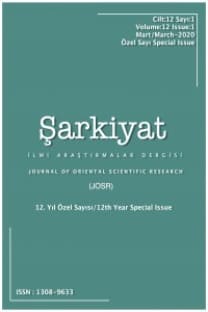Tunus'taki Tasavvuf Akımı ve 15.Yüzyıldan 16.Yüzyıla Kadar İktidarla İlişkisi
Bu araştırma, Tunuslu tasavvuf hareketleri meselesini ve onların 15. ve 16. yüzyıllarda iktidar üzerindeki siyasi tutumunu ele almaktadır. Tunus'taki tasavvuf hareketi, geleneksel olarak toplumsal ve siyasi arenadan izole edilmiş değil, daha çok aktif ve dinamik bir akımdır. Geniş bir ufku ve Arap doğusunda ortaya çıkan tasavvuf tarikatlarından tamamen farklı bir vizyonu vardı. Bununla birlikte, Tunus'taki bu tasavvuf akımı, 16. yüzyılın ikinci yarısından itibaren iki ana bölüme ayrılarak bilinmektedir: Birincisi, siyasi otorite ile barışma yöntemini benimseyen sosyal tasavvuf akımıdır. Siyasi durumu okuma ve denge haritasını gerçekçi ve kapsamlı bir şekilde anlama yeteneğine sahipti. İkinci eğilime gelince, radikal siyasi tasavvuf akımı, ister Tunus'ta ister Kuzey Afrika bölgesinde olsun, olayların gidişatını analiz etme ve doğru okuma mekanizmalarına sahip değildi. Bu nedenle mevcut siyasi otorite ile bir çatışmaya girdi, ancak daha ziyade devletin merkezinden bağımsız bir siyasi varlık kurma yönünde itilmiş, bu da onu birden fazla cephede mücadelesine sokmuştur. Tasavvuf ilk akımını temsil eden Giryâni tarikatı tecrübesi, Osmanlılarla ittifak yoluyla kazanımlarını elde etmeyi ve sürekliliğini korumayı başardı. İkinci tasavvuf akımını temsil eden Şâbbiyye tarikatı ise merkezi otorite ve bölgedeki aktif güçlerle özellikle Osmanlılarla çatışmaya girme politikasına girmiştir.
Anahtar Kelimeler:
tunus, tasavvuf, osmanlılar, hafsiler, şabbiyye, giryaniyye, the shabiya
The Sufi Trend in Tunisia and İts Relationship to Power from The 15th to the 16th Centuries
This research deals with the issue of the Tunisian Sufi movement and its political position on power in the 15th and 16th centuries. The Sufi movement in Tunisia was not traditionally isolated from the societal and political arena, but rather an active and dynamic current. He had a broad horizon, and a vision completely different from the Sufi orders that appeared in the Arab East. However, this Sufi movement in Tunisia has known since the second half of the 16th century, a division into two main parts: the first is the social Sufi current, which adopted the method of truce with the political authority, and had the ability to read the political situation, and to understand the map of balances in a realistic and comprehensive manner. While the second part represented by the radical political mystical current did not have the mechanisms of analysis and correct reading of the course of events, whether in Tunisia or in the North African region, and therefore it entered into conflict with the existing political authority, but rather pushed in the direction of establishing a political entity independent of the center of the state, which Bring it into conflict with multiple fronts.
Keywords:
sufizm, tunisia, the ottomans, hafsids, the gharianite,
___
- El-Acîlî, et-Tilîlî. Et-Turuk es-Sûfiyye ve’l-İstimâr bi’l-Bilâd et-Tûnisiyye.Tunus: Menşûrât Kulliyyet el-Âdâb bi Mennûbe, 1992. el-İstarhî, İbrahim Ebû İshâk. El-Mesâlik ve’l-Memâlik. thk.Muhammed Cabir Abdulâl. Kahire: el-Hey’e el-Âmme el-Misriyye li’l-Kitab, 2004. El-Uteybî Halid bin Nâsır. Et-Tarîka eş-Şâziliyye Arz ve Nakd. Erriyâd: Mektebet er-Ruşd, 2011. eş-Şâbbî, Ali. Arfa eş-Şâbbî Râid en-Nidâl el-Kavmî fi’l-Ahd el-Hafsî. Tunus: ed-Dâr el-Arabiyye li’l-Kitab, 1982.
- Başlangıç: 2009
- Yayıncı: Şarkiyat Araştırmaları Derneği
Sayıdaki Diğer Makaleler
XVI. Yüzyıl Kudüs Sancağı’nda Bir Köy: Beytülahm
Okul Ethosu ve Etik Karar Verme
Azîz Nesefî ve Kıtâb-ı Keşfü’l-Hakâyık Adlı Farsça Eseri
Hz. Peygamber’e (s.a.v.) İsnad Edilen Olumsuz Söz ve Fillerle İlgili Bir Hadisin Tahrîc ve Yorumu
İbrahim Ethem TAŞ, Sadegül DURGUN, Murat BAL
İslam Borçlar Hukukunda Satış Konusunun Maddi Olarak Var Olması Şartına Dair Bir Değerlendirme
Muhammed Parsa’nın Baş Yapıtı: Faslü’l-Hitâb
